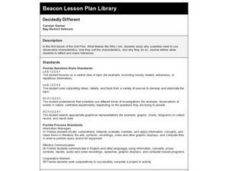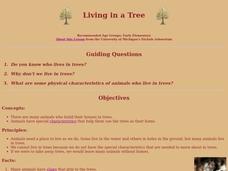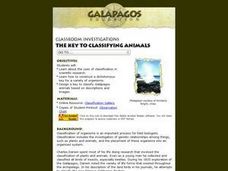Curated OER
Decidedly Different
Fifth graders inquire as to why scientists use observable characteristics, how they sort the characteristics, and why they do so. They write journal entries to be used throughout this unit.
Curated OER
Growing Crystals from Solutions
Students grow crystals in the lab using solutions. In this crystals lesson plan, students set up a crystal growing apparatus using a sugar solution with a thread attached to a piece of copper wire that is inserted in the solution....
Curated OER
A Science Experiment With Crayfish
A crayfish can lead to a science experiment involving habitats, animal behavior, and anatomy..
Curated OER
Living in a Tree
Learners explore animals that live in trees. In this nature and biology lesson, students go outdoors and make observations about animals and their unique body parts that help them to live in trees. Learners create drawings as they...
Curated OER
Charles Darwin
Students produce a newspaper describing the times during which Charles Darwin introduced the theory of natural selection. In this evolution lesson, students make observations and explore the role of observation in Charles Darwin's work....
Curated OER
The Key To Classifying Animals
Explorers of the environment construct a dichotomous key for a variety of organisms and design a key to classify Galapagos animals based on descriptions and images. The lesson includes a link to an animal gallery and the worksheet for...
Curated OER
Chemistry Lab: Chemical Equilibrium
High schoolers investigate the effects of adding or removing a reactant or a product on chemical equilibrium. In this equilibrium lesson plan, students add or remove ions to solutions to determine the effects on equilibrium. They make...
Curated OER
Soil Porosity Lab
In this soil porosity worksheet, students experiment with four types of soil. They fill separate cups with each soil type and pour water in measuring the amount it takes to saturate the soil. They make observations and compare their data...
Curated OER
Water Conditions
Students investigate the importance of water in an environment with living things. in this water conditions lesson plan, students soak radish sees in water, vinegar, soap and alcohol. Students remove the seeds, store them for a few days...
Curated OER
Reactions of Metals with Water, Acid and Air
In this chemical reactions worksheet, students experiment with reactions between 4 different metals with water, acid and air. Students make observations of copper, iron, zinc and magnesium with water, acid and air. They write an analysis...
Curated OER
Science Inquiry - Raisins and Sprite
First graders work in pairs to complete a science experiment involving raisins and Sprite. The pairs predict what they think happens when they put their raisin in a cup of Sprite. The students complete the scientific inquiry by drawing...
Curated OER
Magnets and Interactions
Second graders discover what magnets can do. In this magnet lesson students make predictions about magnets. They experiment with the magnets and record their data on a chart.
Curated OER
Scientific Problem Solving
In this problem solving activity, learners will put the 7 steps to problem solving in a logical order. Then students will design a hypothetical study comparing a person's weight on Earth with his weight on Mars and complete 3 short...
Curated OER
Measuring Snowfall
Students predict the amount of snowfall for the week and measure snowfall. In this measuring snowfall lesson, student use a precipitation gauge to measure the week's snowfall; and analyze the data to determine whether or not...
Curated OER
School House Rock! Science Rock
Middle schoolers use common household and classroom objects to generate static electricity and study its effects. They discuss the video Science Rock CD called Electricity, Electricity. The video explains many things about electricity.
Curated OER
Women of Science
In this important women of science worksheet, students click on the links in the questions about important women of science to find the answers to the questions and then come back and answer the questions. Students answer 16 questions...

















